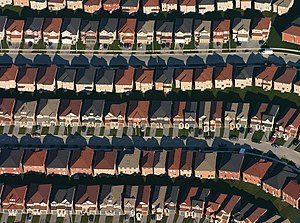Also discussed here: Baby & Hood: Studies suggest urban areas are less risky for children (Tamsin McMahon, National Post, Jan. 22, 2011)
And here: Danger in Exurbia (Urban Planet, Jul.5,2006)
And here: Burbs more dangerous than the city, due to traffic fatalities (Chris Fusco, Bike Forums, May 12, 2002)
Not only does sprawl lead to car dependence, pollution and a less healthy urban environment (as pointed out numerous times in the posts made on this blog), the articles reviewed today analyse the inherent dangers for children living in suburban areas- from collisions with cars to violent crime. The costs for the added health and safety risks in suburbia are paid for by all taxpayers with no premium for those who live there. Why?
Key Quotes:
“Potential dangers in any residential location arise from leaving home to travel to work, shop, attend school, attend church, visit friends, or go to civic functions and family gatherings. Tabulating traffic fatalities is the best method of measuring these dangers”
“the greatest risk to children is car crashes, which are more likely to occur in the suburbs, where children spend more time in cars or playing next to busy roads …In terms of traffic fatalities versus homicides by strangers, it's almost a 13-to-one ratio”
“lower-density areas were the most dangerous, while the safest communities, for the most part, were high-density cities. Not only did low-density communities have more traffic fatalities, but they were also the most dangerous places for stranger homicides”
“Police in Ontario reported in 2009 that both violent crime and fatal collision rates were lower in Toronto than in neighbouring suburban Peel and York regions”
“compared to its suburban neighbours, Toronto had the lowest rates of emergency room visits for motor vehicle collisions among the province's seven health districts, along with the lowest rates of ER visits for cycling accidents involving children and the second-lowest rates of emergency room visits for violent crimes against children”
“Ontario College of Family Physicians warned of the growing body of evidence [that] suggests there are significant public-health costs of spread-out urban development."
“1% increase in urban density translated into a 1.5% decrease in traffic deaths and a nearly 3.5% decrease in pedestrian fatalities”
Related articles
- Slums and Urban Sprawl (pollutionfree.wordpress.com)
- Density Comparisons (randscot.wordpress.com)
- Urban Physics (pollutionfree.wordpress.com)
- A Helmet or a Coffin (osocio.org)
- Foreclosures change color of some suburbs (msnbc.msn.com)
- DC Suburbs: Maryland vs. Virginia (outsidethebeltway.com)
- Buying a home now is a no-brainer (money.cnn.com)
- 'First-ring' suburbs getting second look (dispatch.com)
- Suburb's Veneer Cracks: Mother Is Held in Deaths (nytimes.com)


No comments:
Post a Comment